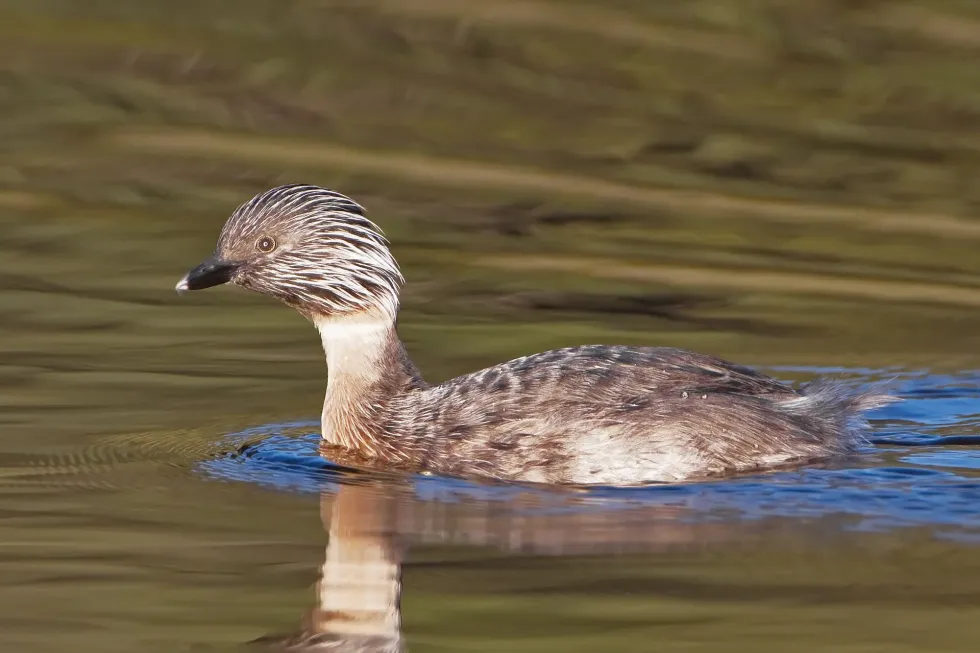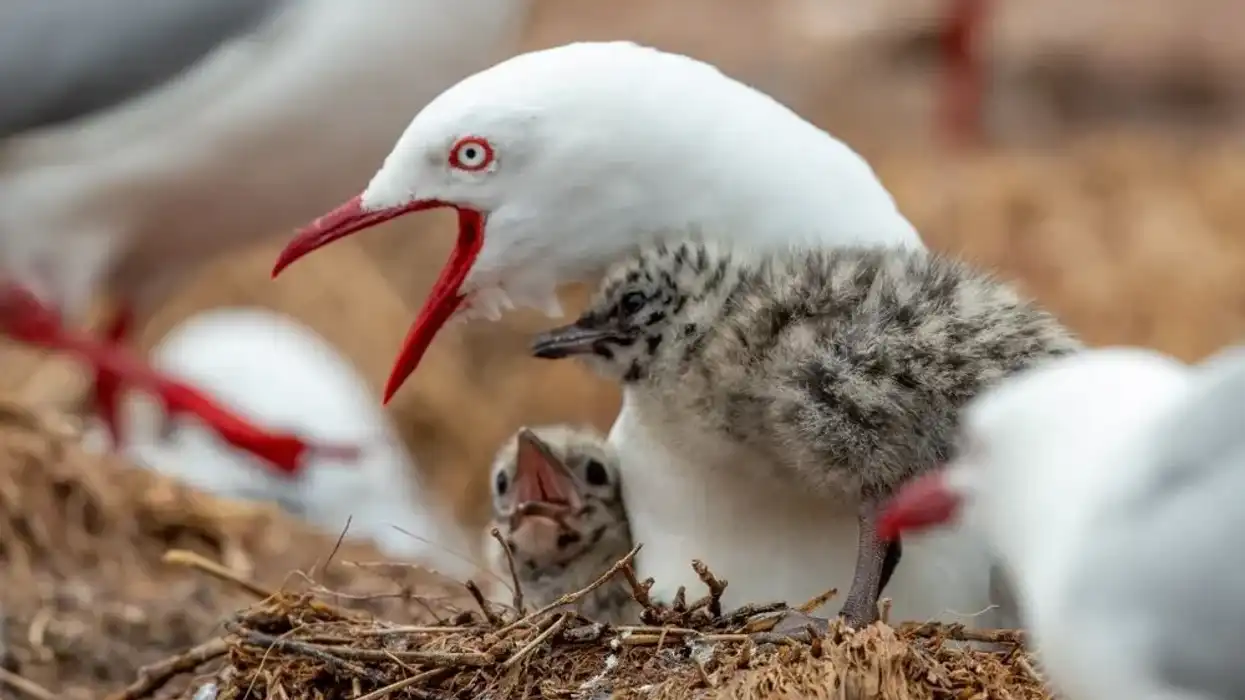A member of the grebe family, the hoary-headed grebe is a medium-sized bird found in all parts of Australia, except for its central dry regions. The bird is well known for its silver streak appearance and nesting habits. They feed on aquatic arthropods such as arachnids, insects, crustaceans, and mollusks.
Although the bird is mostly seen in flocks, sometimes they are known to be alone in pairs. The hoary-headed grebe is a common sight in Australia as compared to New Zealand where it has a stable population count with no global threat to its existence. The bird is dark brown or gray with white plumage.
If you like reading this article, we suggest you read about two more birds - the black cuckoo and yellow-billed cuckoo.
Hoary-Headed Grebe Interesting Facts
What type of animal is a hoary-headed grebe?
The hoary-headed Grebe is an aquatic bird from the species of P. poliocephalus.
What class of animal does a hoary-headed grebe belong to?
The hoary-headed grebe (Poliocephalus poliocephalus) belongs to the Aves class of animals from the family of Podicipedidae.
How many hoary-headed grebes are there in the world?
The population headcount of the grebe is estimated to be about 500,000 in Australia.
Where does a hoary-headed grebe live?
The hoary-headed grebe (Poliocephalus poliocephalus) lives mainly in Australia. It is found in all of the country's territories and states, except for its central arid regions. Other than that, it is also found in New Zealand due to man-made introductions.
What is a hoary-headed grebe's habitat?
The hoary-headed grebe (Poliocephalus poliocephalus) habitat includes open wetlands and freshwaters. The bird also lives in brackish or saline water bodies such as creeks, bays, inlets, and estuaries during winters.
Who do hoary-headed grebes live with?
The hoary-headed grebes usually stay alone by themselves but are occasionally seen with other birds of the same species. The flock usually consists of hundreds to thousands of birds together.
How long does a hoary-headed grebe live?
A hoary-headed grebe's lifespan can be estimated at an average of 10-15 years.
How do they reproduce?
The breeding season of the hoary-headed grebe starts in August. The nest is usually made off the shore around an area filled with lush plants, and other vegetation on the water surface.
This helps the nest to be attached to the plants so it does not float away. There is a low-lying portion on the top of the nest where the eggs are placed.
The parents hide the eggs with plants and other objects whenever they leave so that it remains hidden from predators and stays warm. The incubation period goes on for 22-24 days while the eggs are white and brownish in color.
What is their conservation status?
Being a common sight in Australia, the hoary-headed grebe range is abundant in population even though it is comparatively an uncommon species for New Zealand. There are no such extreme conservatory threats to its existence as far as its number of species is concerned.
However, due to several man-made pollutants and other climatic issues, the birds may face future habitat threats but as of now, they are not globally threatened and currently fall under the status of Least Concern.
Hoary-Headed Grebe Fun Facts
What do hoary-headed grebes look like?
The male grebe is usually bigger in size and longer-billed. The adult breeding birds have silver plumes on their heads that are slightly narrower and give off an overall hairy look.
There's a white line that starts from the base of the bird's mandible and goes below their eyes while their wings and upper portion of the body is brown and gray with few white lines in their inner and middle portion.
The covered portions are usually brownish and a light shade of dark colors, but the abdomen is a perfect white. They have light inner eyering, ivory or black bill, and dark gray and olive legs.
As for the adults who are non-breeding, they look the same as the Australasian grebe but have a dark cap starting from their eyes to their neck while the remaining parts of the body are similar to the breeding adult.
Teenagers are quite different from non-breeding adults but possess a striped neck and head along with a white supercilium. Finally, the chicks are light brown in color with black stripes and lighter shades in their lower body parts.

How cute are they?
The grebe with its unique white striped head and a bushy bum looks like shiny soft toys. Not to forget, baby grebes are super cute and look adorable when they are swimming around with their mothers.
How do they communicate?
The hoary-headed grebe prefers to be silent. This is the main reason why there is no loud communication between the species. The only time they do display communicative behavior is during the breeding seasons. The birds produce a very quiet, rolling, churring, guttural sound that can only be heard from a short distance.
How big is a hoary-headed grebe?
The hoary-headed grebe weighs about 0.48-0.57 lb (220-260 g) and is 10.6-11.8 in (27-30 cm) in length.
How fast can a hoary-headed grebe fly?
The birds usually fly away when they are threatened or alarmed by predators and can travel long distances but the amount of speed used during their flight is not known.
How much does a hoary-headed grebe weigh?
A hoary-headed grebe can weigh from 0.48-0.57 lb (220-260 g).
What are the male and female names of the species?
There are no specific sex-based names given to them so they are usually referred to as the female bird and their male counterparts.
What would you call a baby hoary-headed grebe?
A baby hoary-headed grebe is called a grebette. It is often seen that people usually misunderstand grebette and gribbet for being the same word when the latter is actually used for baby frigatebirds or dinghy birds.
What do they eat?
The birds usually dine on aquatic arthropods instead of fish. Their diet includes insects, crustaceans, mollusks, and arachnids.
It is to be noted that their eggs are usually targeted by crows, black-billed magpies, raccoons, mink, and laughing gulls for food which is why they are mostly seen in flocks and prefer hiding their nests.
Are they dangerous?
No, the hoary-headed grebes are not at all dangerous to human beings.
Would they make a good pet?
Hoary-headed grebes belong to a species of birds who prefer being mostly at the water as much as possible, so keeping them in captivity or as a pet will not result in a healthy environment for them. The birds get very stressed when in confinement.
Did you know…
Many wild animals mate for life. These include swans, penguins, and even seahorses but unlike them, the hoary-headed grebe doesn't mate for life. The birds find temporary partners and produce a single brood during the breeding season.
Different types of grebe
There are a total of 22 species of grebes belonging to the single-family of Podicipedidae that consists of the black-necked grebe, great-crested grebe, little grebe, red-necked grebe, and Slavonian grebe among others.
They are all similar in the way they can go underwater, exert maximum force to fly, are expert divers, walk on dry land, and build floating nests but they all differ in shape, size, sometimes in weight, color assembly, breeding plumage to non-breeding plumage, and behavioral patterns from one kind to another in Australia and New Zealand.
Is hoary-headed grebe endemic?
Yes, the bird is endemic as it was initially a species originating from the country of Australia and was later on introduced in New Zealand, which is why their population in the latter is far less than their actual population count back home in Australia.
Here at Kidadl, we have carefully created lots of interesting family-friendly animal facts for everyone to discover! For more relatable content, check out these secretary bird facts and kea parrot facts for kids.
You can even occupy yourself at home by coloring in one of our free printable hoary-headed grebe coloring pages.









